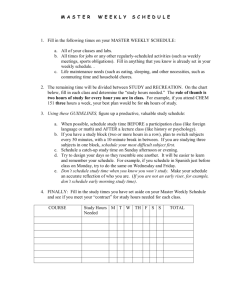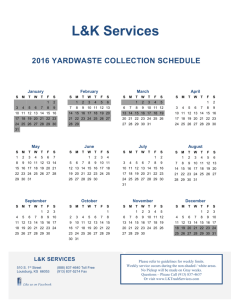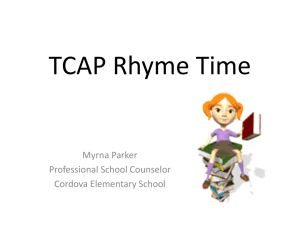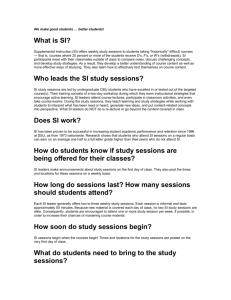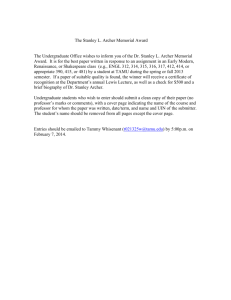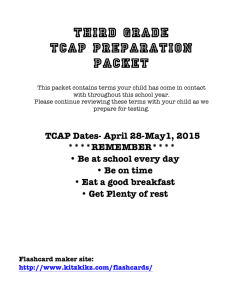2013-2014 Lesson Plan Assessment
advertisement
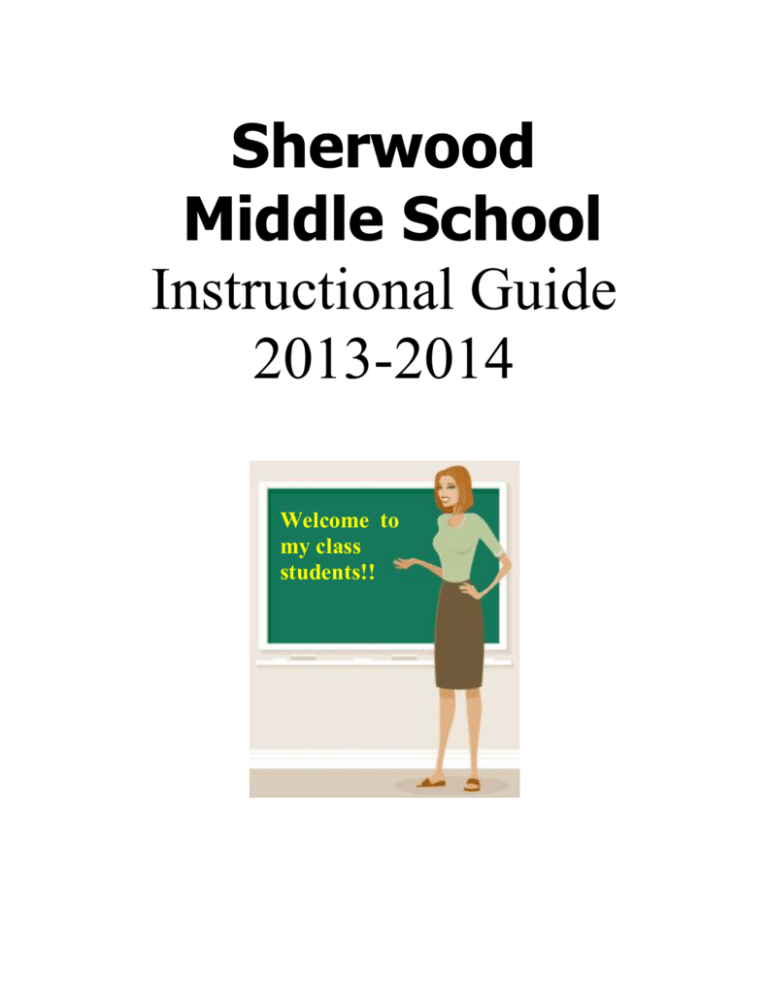
Sherwood Middle School Instructional Guide 2013-2014 Welcome to my class students!! INSTRUCTIONAL PLAN We must never forget that our primary purpose is teaching. The criteria for evaluating any aspect of the school must be its contribution to student learning. Welcome Letter Develop a team welcome letter consisting of the following: team member names, school rules, procedures, and reference student handbook online (scsk12.org). ALL COLLECTED ASSIGNMENTS WILL BE GRADED AND RETURNED TO STUDENTS WITHIN THREE DAYS AND GRADES ENTERED IN POWERTEACHER BY THE FOLLOWING MONDAY. GRADING SCALE A = 100% – 93% B = 92% – 85% C = 84% – 76% D = 75% - 70% F = BELOW 69% Lesson Plans & Weekly Assignment Sheets Lesson plans and weekly assignments sheets are typed and submitted to administration on Sunday by 6 p.m. before the week of the plan. Plans should be clear, concise and complete. Lesson plans should be readily available for a substitute or the principal. A copy of your weekly lesson plans should be posted in the classroom for the current week. Weekly feedback on lesson plans will be provided to teachers. Sherwood Middle School’s instructional plan will serve as the blueprint for instruction in terms of strategies, standards and content. It is based on the premise that all students can achieve at higher levels than those they are presently achieving. This plan will serve as a catalyst toward the development of the School Improvement Plan (SIP). LESSON DESIGN FOR LEARNING Teaching Focus Student Performance Indicators - All teachers are expected to teach from SCS Nine Week Instructional Plans and Pacing Guides. Standards are required to be written and displayed when they are being taught in all content areas. Objectives - The objective for the day should be written or displayed just like the standards. The objective should change daily and it is not the same thing as the SPI. Required activities listed in LA, Science and Social Studies pacing guides must be incorporated into your weekly objectives. Archer’s Do Now - should take place during first five minutes of class and involve students in a written activity, focusing specifically on SPI’s. Please use TCAP objectives as your Archer Do Now activities. They can be switched around to address topics covered the previous week. Motivation – During motivation, the teacher peaks students interest by relating new knowledge to prior learning, experiences or current interests. All students actively participate in this portion of the lesson. Teaching Strategies – It is not our aim to mention all teaching strategies, but to encourage teachers to become aware of such strategies, and use them. Basic things are expected to be seen in the classroom such as: Student – Centered/ Active Hands-On Activities - This is a must and it may require you to rearrange the room or use cooperative learning. Involve students in the class organization and encourage active participation at all times. At least 3 strategies a day should be used during each class. State Mandated Test Preparation – Prepare students daily for the upcoming TCAP test. Make note of which SPI’s should be introduced, assessed, or mastered during each nine week period. This should be monitored on the nine-week SPI/GLE Mastery charts and should be updated weekly with Common Weekly Assessment Results. Student Activities - Students should be engaged in thought-provoking, challenging work. Students should be actively engaged at all times and a variety of strategies should be utilized each day. Assessment Activities -A variety of assessment activities should be utilized in the classroom on a regular basis. Do Now, classroom participation, homework, class work, test and quizzes, and projects should be used to determine a student’s grades. Please see the next section on grading procedures for more details. Closure/EOCA (End of Class Assessment) - Closure is a time for the students to reflect on and restate what they have learned during instruction. All students should participate in closure activities. Weekly Word Wall/ Vocabulary/Content Reading – Each discipline will develop content vocabulary and vocabulary list for students. In class discussions and assignments, the students must use the vocabulary with proficiency. Each classroom should display a WORD WALL listing the vocabulary words used during the current week’s course of study. The word wall should change weekly. Vocabulary should be assessed each week and a vocabulary list should be included in each week’s lesson plan. The TN Academic Vocabulary should also be posted close to the word wall in your classroom. Quality Work –Student work should be displayed on a monthly basis in your classroom. As students complete high quality student work, display it. This encourages students to do their best. Quality work displays in the halls should be changed by the first Monday of each month. Common Assessments(CA’s)- Language Arts, Math, Science and Social Studies teachers will administer a common bi-weekly assessment test to assess student mastery of content. Tests will be created by the administrative staff and will be based on the SPI’s/GLE’s listed on the 9week pacing guide. These tests should serve as the student’s weekly test. Teachers will be responsible for reporting performance of CA’s to administration. This instructional plan is considered basic expectations for all teachers at all times. The principal, assistant principals and leadership team will monitor and assist in any way possible. These items will be EXPECTED during daily DROP- INS 1. Points to Remember: Ensure Student Academic Achievement by: providing bellwork (Archer Do Now) that students can start working on as they enter the classroom. Being firm but fair and consistent with all students. Encouraging students to have their textbooks, pencils, supplies, paper, and other pertinent materials daily. Not ending the instructional day before 4:00 p.m. Participating in and supporting all school functions that directly benefit the school as a whole. Notifying parents weekly through written (Wednesday Folder) and/or oral/electronic communication of academic as well as behavioral progress/concerns. Submitting lesson plans to the principal by 6 p.m. each Sunday for the following week. Providing a Substitute Folder, with relevant purposeful assignments for any day or period you are not present. Making Effective Use of the Textbook The textbook has been the basic tool of teaching from the beginning of education as an institution. Throughout the years, the purpose of textbooks has remained the same: • Provide Content Basis for the Class • Evaluation/Testing • Pre-Planned Activities However, with the changes in state standards, the textbooks simply do not address all the skills needing mastery adequately. Therefore, teachers must remember, the textbook is simply a resource. It does not determine objectives nor drive instruction. How to Make the “Boring” Fun Successful teachers learn how to go beyond the textbook and distill the core elements or objectives of the lesson. The master teacher knows that the text does not teach the class – the teacher does. Teachers have developed a variety of techniques to engage the students’ interests. These techniques tend to drive home information and get students excited about school. Here are some examples: • Quiz Shows • Dramatic Interpretation • Costumes • Audio-Visuals • Manipulative • Simulations • Oral Readings • Word Games/Puzzles Strategies Checklist: Teacher-Directed Strategies Student Directed Strategies Discussion Discovery Question/Answer Higher Level Questioning Modeling Concept Attainment Demonstrations Reciprocal Teaching Lecture Inquiry Videos Learning Centers Field Trips Technology Technology Presentations Experimentation Drama Higher Level Thinking It is not enough to teach just the basics. Society demands more emphasis on high-level thinking. Extending questions by students into larger issues, demanding reasoning skills, asking for judgments, and creating high-level projects are part of every successful teacher’s curriculum. Use of Bloom’s taxonomy will help teachers guide students to HOTS. (Higher Order Thinking Skills) Thinking Process KNOWLEDGE Identification and recall of information COMPREHENSIO N Organization and selection of facts and ideas APPLICATION Use of facts, rules and principles ANALYSIS Separation of the whole into component parts Useful Verbs Sample Question Stems Potential Activities and Products tell list describe relate locate write find state What happened after...? How many...? Who was it that …? Can you name the...? Describe what happened at.? Who spoke to…? Can you tell me why...? Find the meaning of …? What is...? Which is true or false? List the story's main events. Make a timeline of events. Make a facts chart. List any pieces of information you can remember. Recite a poem. List all the animals in the story Make a chart showing Make an acrostic. explain interpret outline discuss distinguish predict restate translate compare describe Can you write in your own word…? Write a brief outline ... What do you think could have happened next..? Who do you think …? What was the main idea? Who was the main character? Can you distinguish between . . .? What differences exist between …? Can you provide an example of what you mean by...? Can you provide a definition for...? Do you know another instance where? Could this have happened in...? ? Can you group by characteristics such as.... ? What factors would you change if? Can you apply the method used to some experience of your own..? What questions would you ask of…? From the information given, develop a set of instructions about...? Would this ",formation be useful if you had a...? Cut out or draw pictures to show a particular event. Illustrate the main idea. • Make a cartoon strip showing the sequence of events. Write and perform a play based on the story. Make a coloring book Retell the story in your own words. Paint a picture of some aspect of the story you like Write a summary of the event. solve show use illustrate calculate construct complete examine classify analyze distinguish examine compare contrast investigate categorize identify explain separate advertise Which event could not have happened if . . ? If ___ happened, what might the ending have been? How was this similar to . . .? What was the underlying theme of . . .? What do you see as other possible outcomes? Why did ___ changes occur? What must have happened when . . . ? How is . . . similar to . . . ? What are some of the problems of . . . ? Can you distinguish between. . . ? What was the turning point of the story.. .? Construct a model to demonstrate how it will work. Make a diorama to illustrate an important event. Compose a book about Make a scrapbook about the areas of study. Make a paper-mache map showing information about an event. • Make a puzzle game using ideas from the study area. Prepare a flow chart to illustrate the sequence of events. Make a clay model of Paint a mural. • Design a market strategy for your product. Design a questionnaire to gather information Make a flow chart to how critical stages Write a commercial for a product Construct a graph to illustrate selected information Construct a jigsaw puzzle Analyze a family tree showing relationships Write a biography about a person being studied Arrange a party and record/list the steps you took SYNTHESIS Combination of ideas to form a new whole EVALUATION Development of opinions, judgments and decisions Create compose predict plan construct design 'imagine improve propose devise formulate Can you design a – to ---? What is the possible solution to. . . ? What would happen if . . . ? If you had all the resources, how would you deal with. . ? How many ways can you…? Can you create new and unusual uses for –___? Can you develop a proposal which would - - ? How would you compose a song about? Can you write a new recipe for a tasty dish? Invent a machine to do a specific task Design a building Create a new product – name it, marketing plan Write about your feelings in relation to . . . Write a TV show, play, puppet show, song, . . . Design a record, book, or magazine cover for . . . Devise a way to . . . Create a language code Sell an idea to a billionaire Compose a rhythm or put new word to a known melody judge select decide justify debate verify argue discuss determine prioritize access, rate Is there a better solution for ____? Judge the value of ___? Defend your position about . . . ? Do you think __ is a good or bad thing? Explain. How would you have handled . . .? What changes would you recommend? Why? Do you believe? Are you a ___ person? Why? How would you feel if ___? How effective are _____? What do you think about . . . ? Prepare a list of criteria to judge a show. Indicate priority and ratings. Conduct a debate about an area of special interest Make a booklet about five rules you value Form a panel to discuss a topic. State criteria Write a letter to _____ advising changes needed Prepare arguments to present your view about . . . Learning Styles The theory of learning styles can be generally summarized as follows: • All students have the capacity to learn • Students can learn the same things by different methods • Recognizing how a student learns is critical to success The implications for the teacher are that one must be able to recognize how a student learns best and adjust to that style. It is the teacher’s responsibility to differentiate instruction and assessments to address all learning styles. Special Needs Students Traditionally kept out of the regular classrooms, students with special needs are making an impact on the regular teacher. Help and support for these special students can be given first by understanding that in most cases they cannot help their behavior without assistance from the teacher. Monitor these students carefully and use preventive discipline techniques as much as possible. Talk to the parents, former teachers, and counselors of these students to get ideas that work. It is also very important to be aware of the medications used by these students and their possible side effects. Common special needs are: • ADD (Attention Deficit Disorder) • ADHD (Attention Deficit Hyperactivity Disorder) • “Slow Learners”/General Learning Disability • Dyslexia • Wheelchair Bound • Hearing/Visually Impaired • Emotionally Disturbed • Bilingual • Gifted Reading Across the Curriculum In Middle school, every teacher is a reading teacher. It is impossible to overstate the importance of reading on the adolescent brain. It is the classroom teacher’s responsibility to motivate students to read. This can be done by various ideas such as reading books, magazine articles, or the newspaper. The idea is to get every child into the habit of reading. RESOURCES: Texts and Online Resources Available Throughout the District http://edhelper.com/ http://www.education-world.com http://www.eduplace.com http://www.eduplace.com/activity http://glencoe.com/ http://gohrw.com/ http://www.internet4classrooms.com/ http://www.mcsk12.net http://read180.com/ http://www2.scholastic.com/browse/index.jsp http://school.nettrekker.com http://ww.studyisland.com/ www.scsk12.org www.pearsonsuccessnet.com www.tenn.gov. www.manatee.k12.fl.us www.questioning.com http://www.teaching uk/talk/questions/english.org http://www.tennesseestandards.com www.bbc.co.uk www.enchantedlearning.com www.tennesseeassessments.com www.tncore.org www.engageny.org www.ncpublicschools.org/arce/standard s CHARACTERISTICS OF EFFECTIVE MIDDLE SCHOOL TEACHERS The Middle School Teacher should: be committed to the education of middle school students have a positive self-concept have an understanding of the nature of the middle school child and know how they learn best have patience and understanding be able to communicate effectively with middle school students have a positive attitude toward students be enthusiastic and exciting to stimulate the curiosity of students be flexible and open to change and innovation demonstrate resourcefulness in providing the varied experiences needed by middle school students understand that the student is a product of his or her environment and is at a unique stage in growth and development be responsive to the intellectual, personal, and social needs of the student be knowledgeable in his or her subject area and bring it to the level of the learner be able to work with other teachers. CHARACTERISTICS OF MIDDLE SCHOOL STUDENTS The Middle School Student: possesses new intellectual powers lives under the impact of puberty struggles with turbulent emotions, i.e. anger, love, hate is searching for self-identity begins to assert autonomy and independence needs and seeks peer approval and acceptance (a need to belong) often lacks self-confidence needs to feel wanted, worthwhile, and trusted experiences a radical change with parents, peers, and the opposite sex has a new physical body to master (growth of long bones) needs to develop social skills in dealing with others is extremely idealistic has a fluid and flexible self-concept is easily frustrated is very impressionable has a high energy level has rapidly multiplying but superficial interests should be involved in group games and activities may attempt to gain adult status by trying to imitate adult behavior in language, dress, and use of cosmetics expects adults to recognize the importance of his or her friends and activities Tennessee Academic Vocabulary Language Arts 6th Grade 7th Grade 8th Grade Employ Foreign phrases Genre Hyperbole Imagery Inference Mnemonic devices Writing modes Multiple meanings Personification Rhyme Rhythm Point of view Propaganda Relevant Relevancy Sequential order Sidebars Simile Symbolism Text features Thesis statement Stressed/unstressed syllables Clauses Interaction with texts Paraphrase Etymology Semantic change Connotation Denotation Stress Pitch Juncture Onomatopoeia Accent Repetition Foreign phrases Internal rhyme Irony Mood Foreshadowing Flashback Tone Inferences Viewpoint Epilogue Assonance Consonance Nuance Climax Double-negative Allusion Antecedent Bias Clincher sentence Coherent order Composition Cross-reference Debate Derivation Dramatization Elaboration Facilitator (role identification/groups) Gerund Inferring Jargon Inductive reasoning Deductive reasoning Inflection Enunciation Rate Pitch Participles Persuasive writing Preface Reliability Sensory detail Shades of meaning Tension Thesis statement Mood/tone Acronyms Sidebars Footnotes Endnotes Tennessee Academic Vocabulary Mathematics 6th Grade Base (of exponent) Cartesian coordinate system Circumference Compound event Degree (angles) Dependent events Dilation Equiangular Equilateral Experimental probability Inequality Theorem Integers Interior/exterior angles Isosceles Negative Odds Percent Pi Poll Power Prime factorization Protractor Pyramid Qualitative graph Random Rate Ratio Repeating decimal Sample bias Sample space Sample, sample data Scalene Similarity Simple event Simulation Theoretical probability Triangle 7th Grade Absolute value Additive inverses Box & whisker plot Coefficient Cube root Function Function notation Greatest common divisor Greatest common factor Histograms Intercepts Interquartile range Least common multiple Linear equation Negative exponents Perfect square Property Proportional relationships Quartile Scatter plots Scientific notation Slope Square root Unit rates 8th Grade Adjacent angles Alternate exterior angles Alternate interior angles Complementary angles Corresponding angles D=rt (distance = rate x time) Function families Hypotenuse Infinite Legs of a triangle Line of best fit (conceptual) Monomial Nonlinear equation Perfect square Pythagorean Theorem Quadratic equations Sequence Slope intercept form Supplementary angles Transversal Vertical angles Vertical test Tennessee Academic Vocabulary Science 6th Grade 7th Grade abiotic atmospheric convection adaptive engineered technologies assistive engineered technologies asteroid bias biome biosphere biotic cause and effect chemical potential energy climate change conductivity control criteria design constraint elastic potential electrical conductor energy transformation gravitational potential energy hygrometer meterological data ocean current protocol prototype psychrometer scavengers simple circuits tides variable acceleration amplitude asexual reproduction cell division cell organelles (ribosome, mitochondria, chloroplast, vacuole, lysosome) chromosome crest diffusion dominant trait gene genetic characteristic genetic engineering genotype igneous longitudinal wave mechanical advantage metamorphic minerals mitosis momentum monohybrid cross organ system osmosis phenomenon phenotype Punnett square recessive trait respiration rock cycle sedimentary semi-permeable sexual reproduction simple machines speed synthesize tissue transverse wave trough velocity 8th Grade acid atom (electron, neutron, proton) atomic mass atomic number base biodiversity chemical change chemical equation class compound density dichotomous key diffusion domain electromagnet electron element endothermic exothermic family genus gravitation (universal law) kingdom magnetic field neutral neutron order particle motion physiological adaptation phylum product proton reactant species variation Tennessee Academic Vocabulary Social Studies 6th Grade Ancient Civilizations Irrigation Middle Ages Monarchy Nomadic Technological Empire Epics Feudalism Renaissance Anthropology Republics Caste Cultural diffusion Archaeologists Theocracy Philosophy Geologist Polytheism Cuneiform Globalization Interdependence (economic) Class Dynasty Hieroglyphics Dark Ages Classical Cartouche Plague Mythology Medieval 7th Grade Colonization Demographics Urbanization Impact Prime Meridian International Date Line Time zone GIS/GPS Capitalism Communism Socialism Free enterprise Tributary Topography Physical processes Spatial 8th Grade Philanthropy Altruism Antebellum Absolute Exchange Commerce Congressional Civic efficacy Constitutional Contract Consumption Autocracy Oligarchy Dictatorship Diplomacy Domestic Doctrine Federalism Holocaust Human impact Infrastructure Insurrection Interdependence International Map projections Nationalism Magna Carta Recession Relative Republicanism Social norms Totalitarian Vernacular Autocracy Oligarchy Dictatorship PRODUCT POSSIBILITIES What can I do besides write a report? Create a model Write & produce a play Make a game Create a slide show Write a book Create a filmstrip Paint a picture Draw a diagram Do a puppet show Create an advertisement Make a diorama Give a speech Have a panel discussion Make a photo album Collect Pictures Keep a diary Make a calendar Make a relief map Make a tape recording Make a video tape Make a map Make a collage Make a mural Write a letter Make a piece of art Take a survey Design an experiment Produce a film Make a slide presentation Draft a petition Make a lithograph Write a computer program Design needlework Make an etching Create a dance Teach a lesson Design a wall hanging Build a planetarium Give a demonstration Conduct an interview Create a political cartoon Make a list Make a travel brochure Write a poem Draw a graph Compile a booklet Develop a set of student prints Draw a set of blue prints Create a word play game Create a radio program Create a bulletin board Write a new law Make a transparency Submit items to a magazine Write an autobiography Write a song Design and construct a new product Write an opinion article Make a learning center Compile a newspaper Invite a speaker Make a dictionary Make a collection of. .. Create a recipe Make a puzzle Compile a portfolio of sketches Make a mobile Plan a journey Write an essay Present a mock trial Develop a display Make a simulation game Design and make costumes Make an ammonia imprint Formulate a scientific theory Make an animated movie Write and tape a conversation Create a slogan or bumper sticker Prepare a TV program Create a musical instrument Hold a press conference Write a story Illustrate a story Make a timeline Make a videotape Conduct a debate Conduct a training session Be a mentor Prepare & serve ethnic food Do a pantomime Write a letter to the editor Collect and analyze water samples Develop and use a questionnaire Write a news report BOARD PROTOCOL TEACHER INFORMATION- must be posted Where? - Most visible place in the room for visitors entering the class. - If space is not available to the left side of the work board, post information above the work board to the left side. How? - Post information on poster sized paper, using the poster maker. - If poster make is unavailable, use 11” x 17” copy paper. What should be posted? - Name - Grade/Subject - Planning - Tutoring Schedule (Upon request) - E-mail Address - School Telephone number BOARD INFORMATION-must be visible daily Where? - Most visible place in the room for visitors entering the class. What information should be posted? - Day & Date - Standards - SPI’s/GLE - Objectives “I Will” - Agenda (Archer’s Do Now) - Class work - Assessment & Reflect - Homework *Update information before leaving each day. TEACHING STRATEGIES Common Subject Area Planning (CSAP) Common Assessment (rigor) WHAT? Common subject area planning (CSAP) is a collaborative meeting between two or more teachers that focuses on the sharing of best teaching practices. WHOM? CSAP meetings will take place between common subject area teachers within a specific grade. For example, 6th and 7th grade English teachers will meet as a team for planning and sharing). HOW? Teachers will be required to collaborate in CSAP meetings weekly during scheduled PLC. Teachers will focus on lesson planning, instructional delivery methods, and data sharing. Minutes will be recorded and kept in a notebook that will be turned in to Mr. Kelly weekly. Common assessment is the practice of forming an assessment, utilizing higher levels of Bloom’s Taxonomy, which is created by a team of teachers that teach like-subjects on the same grade level. Rigor is best defined as being challenging instruction rather than difficult instruction. Teachers will use data from common assessments to drive instructional decisions. Teachers will create common assessments as part of common CSAP meetings. Assessments will be created from SPI’s and delivered through a TCAP format. Common assessments will be turned in weekly to Mr. Kelly. Questions can come from Examview, Discovery, TCAP prep books, any other TCAP format source. Rigor can be defined by the levels of Bloom’s Taxonomy. For example, students who are asked to research a problem (cognitive), debate the issues (affective), and use multiple strategies to deliver instructions (psychomotor), are being challenged with a content-rich rigorous lesson. Archer’s Do Now The Archer’s Do Now is a 5 minute warm-up activity that is aligned with TCAP objectives. The Archer’s Do Now should reflect on higher order thinking skills and should be grade level appropriate. It is suggested that the The Archer’s Do Now is used by teachers to assess previously taught skills. Teachers will create TCAP formatted questions, utilizing higher order thinking skills to assess previous learning. Students will complete the Archer’s Do Now upon entering the classroom. After students have completed the Archer’s Do Now, the teacher will discuss the answer with Archer Do Now assigned for the week should be reviewed on Friday. the students. On Fridays, teachers will re-assign questions from the weekly Archer’s Do Now assignments as part of data driven common assessment. End of Class Assessment (EOCA) The EOCA is an activity that is aligned with TCAP objectives. The EOCA should reflect on higher order thinking skills and should be grade level appropriate. It is suggested that the EOCA assigned for the week should be reviewed on Friday. The EOCA is used by teachers to assess previously taught skills. Teachers will create TCAP formatted questions, utilizing higher order thinking skills to assess previous learning. Students will complete the EOCA at the end of the class period. After students have completed the EOCA, the teacher will discuss the answer with the students. On Fridays, teachers will re-assign questions from the weekly EOCA assignments as part of data driven common assessment. Teachers can go online and access the curriculum guides (www.scsk12.org). Teachers will use the curriculum guide in the weekly CASP meetings to plan effective, data driven instruction. Curriculum Guide Curriculum Guides are a Shelby County Schools guide that is used to plan weekly instruction. Teachers will use the curriculum guides as a way to plan instruction. Teachers will still have the flexibility to plan for re-teaching. Pull Out Pullouts are small groups, formed by using previous assessment data, used to deliver enriched instruction. Students will be selected from previous assessment results. Groups will be determined by principals and teachers based on current assessment data. Targeted Tutoring Targeted tutoring is a planned session used to deliver TCAP practice. Students will be selected for targeted tutoring based on data from assessments. Principals and teachers will identify possible students. Students will meet for planned tutoring sessions. Test Taking Test taking strategies are methods and processes used to teach students how to Test taking strategies will be taught by Ms. Clark and Ms. Harp. Ms. Clark, Ms. Harp, and selected teachers will visit classrooms to deliver test taking strategies. effectively take standardized tests. Vocabulary and Spelling Instruction Vocabulary lists are a set of words that are introduced in daily instruction that are used to teach students to speak in content and grade specific language. Teachers will collaboratively develop content specific vocabulary lists that will be used to build an enriched vocabulary. Teachers will create vocabulary lists from both content instruction and state created vocabulary lists. SHERWOOD MIDDLE SCHOOL PERSONAL PROFESSIONAL DEVELOPMENT 2013-2014 School Year Teacher Name: _________________________ DATE TITLE PRESENTER SITE SHERWOOD MIDDLE SCHOOL Components of Quality Work Checklist Quality Work displays should contain the following components: Standards based Current Grade appropriate Purpose clearly defined (what is to be learned) Performance task (what are the students asked to do) Rubrics (criteria for displaying) Technology use Standards/specific expectation Higher order thinking skills (Did task require skills in application, analysis, evaluation or synthesis levels on Bloom’s) Free of Grammatical Errors SHERWOOD MIDDLE SCHOOL Subject Area Minutes Date Team Time Location ______________________ Members Present: Others Present: ______________________________ Administrator’s Signature Notes: _______________________________________________________________ Next Meeting Date: Time: Location: SHERWOOD MIDDLE SCHOOL Morning Inspirational Moment Grade/HR ______________________ Date: __________________ Good morning, this is __________________________________________ representing homeroom _____________ at Sherwood Middle. Where our motto is, “We are A.I.M. ED and focused for success. Sherwood Archers Always respect self, others, and property; Initiate higher-level thinking; and Make good decisions” At this time, I ask that there be no walking and no talking. (PAUSE 5 seconds) Please pause for a moment of silence. (PAUSE) Please stand for the pledge of allegiance: I pledge allegiance to the Flag Of the United States of America, And to the Republic for which it stands: One Nation under God, indivisible, With Liberty and Justice for all. You may be seated. (Pause for 5 seconds.) Our thought for today is: _______________________________________________________________________ _______________________________________________________________________ _______________________________________________________________________ Remember as we begin our day: Archers will always be in the RIGHT Place, at the RIGHT time, doing the RIGHT thing. Sample Substitute Instructional Sheet Date(s) of Absence Schedule of Classes 8:00 – 8:15 – Homeroom (7-10) 8:20 – 9:40 – 2nd period (7-10)…..Pre-Algebra 9:45 – 10:35 – 3rd period (7-09)……Pre-Algebra 10:40 – 11:35 – 4th period………………Planning Pick up students on the Main Hall and escort them back to the 2nd Floor 11:40 – 12:35 – 5th period……………Math Exploratory 12:40 – 1:10 – Lunch…………………Lunch Escort students to lunch and pick them up promptly at 1:10 p.m. 1:20 – 2:15 – 6th period……..……...Exploratory 2:20 - 4:00 - 7th period…….……….Pre-Algebra Assignments Pre-Algebra (2nd, 3rd, and 7th Periods) Worksheet Packet (5 sheets) Show all your work No calculators Math Exploratory (5th and 6th) Be A Better Reader books (under each desk) Pages 109 – 113 Geometric Terms Pages 141 – 145 Reading Graphs Dismissal – Dismissal – Dismissal 3:50 p.m. – Release the walkers (list names of walkers on an attached sheet) 4:00 p.m. – Release all other students Dismissal post – front sidewalk Helpful Team Member – Carrie Clark Helpful Students Homeroom, 2nd, and 6th periods: Cathy Good, Johnny Best 3rd and 5th periods: Marvin Goodtree, Martha Good 7th period: Carrie Clark Thank you in advance. (Teacher’s Name) SHERWOOD MIDDLE SCHOOL Team Planning Guidelines Each team will create the following documentation: A supply list for parents and students. Display list in team area. Team rules/discipline plan (Posted) A team library schedule and team calendar with information on parent meetings, student academic recognitions, fieldtrips, and team meetings, Team Activities. A list of supplies needed for classroom instruction. Schedule for restroom and locker times The team meetings will operate under these guidelines: Will meet at least three times a week The team leader should maintain copies of agenda and minutes. Meetings should last no more than 15 – 20 minutes. Assign roles before the meeting. Discuss student and team progress; what is and is not working, and provide solutions to what is not working. Do not spend time giving negative feedback on students. Sherwood Middle School Textbook Inventory Form 2013-2014 Teacher: Room # Subject: Grade/Section: Student’s Name Date Student’s Signature Date Book # Issued Condition Returned Student’s Signature SHERWOOD MIDDLE SCHOOL Format for Effective Instruction Teacher: Number of Students: Observer: Date: Time in: Board Protocol _____Name _____Planning Period _____Objective/Guiding Question _____Tutoring Class: Objective: _____Subject Time out: _____SPI _____Assessment 1. ______ Students complete Archer Do Now 2. ______Teacher does an assessment and overview of the Archer Do Now 3. ______Teacher introduces the day’s lesson (this includes specifically stating what is to be learned and the expected outcome). 4. ______Teacher models the learning. ______Teacher does and example. ______Teacher does and example assisted by the students. ______Students do an example assisted by the teacher. ______Students do an example. 5. ______Students complete a related active. (The teacher actively monitors the activity to ensure time on task). 6. _____Teacher assesses the learning (Uses variety of strategies and assessment to determine if students learned the intended information). Commendations: Recommendations: Assessment ______Rigor ______________________________________________________________ ______________________________________________________________ ______________________________________________________________ ______________________________________________________________ ______________________________________________________________ ______________________________________________________________ ______________________________________________________________ ______________________________________________________________ ______Basic ______Below Basic 2013-2014 Lesson Plan Assessment Teacher: _____________________________________ Date: ___________________ Component Yes No N/AA Comments Curriculum Connections The plan shows evidence of curriculum implementation and following AMW pacing guide. Integration of content is included where appropriate. Concepts/vocabulary are included. SPIs/GLE’s are included. Objectives Objectives are measurable and relevant. Instructional Strategies Strategies are varied (three per lesson). Strategies are differentiated when appropriate. Strategies include technology integration when appropriate. Student Activities Students participate throughout the lesson in a variety of ways Reinforcement/enrichment activities are included. Required pacing guide activities are included in plan. Assessment Activities Students are assessed verbally and through written work Formative assessment activities occur to monitor student mastery Students are assessed through homework Students are assessed through classwork Students are assessed through test & quizzes Students are assessed through alternative assessment projects Closure Activities All students restate the learning or do “one more”. Closure requires written & verbal response by students Closure activities vary day-2-day. Areas of Strength: Areas to be Strengthened: Principal Signature Date reviewed
